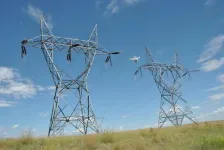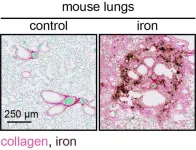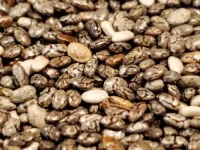(Press-News.org) Electricity is an indispensable resource for our daily lives; it powers our homes, industries, and agriculture, among other things. Electricity is generated in power plants that are often located in remote areas due to safety and environmental concerns. The generated electricity is then transported to residential and industrial areas through transmission lines. However, these remote locations pose challenges in terms of harsh environments that can easily damage the transmission lines. Therefore, regular inspection and maintenance of these lines are crucial to maintaining an uninterrupted electricity supply.
The rapid development of microelectronics has led to the popular use of unmanned aerial vehicles (UAVs) for such tasks. However, the inspection of transmission lines is intricate owing to their small sizes, long spans, and severe magnetic field interference affecting UAV microelectronics. Current methods address these challenges using high-precision sensors and sophisticated equipment, but this makes UAVs heavy and costly, and raises security risks.
Now, a team of researchers, led by Associate Professor Satoshi Suzuki from the Graduate School of Engineering at Chiba University in Japan, has developed an innovative low-cost UAV for inspecting transmission lines. In contrast to the expensive components used in other methods, this approach utilizes a global navigation satellite system (GNSS) receiver, RGB camera, and a millimeter (mm) wave radar. Dr. Suzuki emphasizes: “Our proposed system enables small drones to inspect transmission lines at close range for the first time. This innovation can lead to the automation of power facility inspections, promoting a more sustainable power supply.” Their findings were published in Volume 15, Issue 19 of the journal Remote Sensing on October 06, 2023. The study included contributions from Qi Wang (first author), Professor Akio Namiki (last author), and Ziran Li from the Graduate School of Science and Engineering at Chiba University and Professor Wei Wang from Jiangsu Collaborative Innovation Centre of Atmospheric Environment and Equipment Technology at Nanjing University of Information Science & Technology, China.
The proposed system utilizes sensors to characterize transmission lines and implements a knowledge-based line identification system, which employs a specialized technique called Hough transform to identify and measure the distance of transmission lines from the UAV, enabling it to fly in close proximity. Additionally, a heading correction module counters magnetic field interference affecting the UAV’s compass, calculating the desired direction based on the identified transmission line’s start and end points, and correcting the UAV accordingly.
Furthermore, a waypoint correction system addresses the mismatch between the planned and actual path of the UAV caused by the low accuracy of the GNSS receiver. An auxiliary controller is also employed to address unknown disturbances during inspection, such as strong winds, which can deviate the UAV from the planned path.
The team tested their designed UAV to inspect a 10 kV energized transmission line. Their experiments demonstrated that the proposed method effectively addressed magnetic interference problems as well as mismatches between the planned and actual path, and resisted wind interference. Nevertheless, the team acknowledged that the proposed method has room for further improvement, suggesting that more advanced control algorithms could enhance wind resistance.
“By addressing the challenge of remote inspections, this method can ensure an uninterrupted electricity supply, contributing to the sustainable development goal of ensuring access to clean and affordable energy. Moreover, this method also holds the potential for carrying out automated maintenance work,” highlights Dr. Suzuki.
In conclusion, the development of this novel low-cost UAV platform represents a significant stride toward automated inspection of transmission lines, ensuring regular monitoring and reducing manual effort.
About Associate Professor Satoshi Suzuki
Satoshi Suzuki is currently an Associate Professor at the Graduate School of Engineering, Chiba University in Japan. He received the 36th Academic Journal Paper Award from the Robotics Society of Japan in 2022. His research focuses on manufacturing technology, including mechanical, electrical/electronic, and chemical manufacturing, as well as control systems engineering. He has published around 100 research articles, which have been cited over 150 times.
END
A novel low-cost unmanned aerial vehicle platform for electrical transmission line inspection
The novel approach avoids costly and sophisticated equipment, while also enabling automated close-range inspection of transmission lines
2023-12-14
ELSE PRESS RELEASES FROM THIS DATE:
Popular blood thinner associated with higher risk of bleeding complications
2023-12-14
When diagnosed with a blood clot or atrial fibrillation, patients are often prescribed anticoagulants, or blood thinners, to prevent a future clot.
In a study of the three most commonly prescribed blood thinners, the oral anticoagulant rivaroxaban, known by the brand name Xarelto, was associated with a significantly higher risk of bleeding complications than apixaban (brand name Eliquis) and warfarin for patients with blood clots or atrial fibrillation.
The findings, reported at the 2023 American Society ...
Study shows tree nuts as snacks reduces metabolic syndrome risk in Millenials
2023-12-14
DAVIS, CA, December 14, 2023 – A recent study published online in the journal, Nutrients[1], suggests daily tree nut consumption reduces the risk of metabolic syndrome (MetSx) by improving waist circumference, lipid biomarkers, and/or insulin levels, without requiring calorie restriction, in young adults.
In a randomized, parallel arm, dietary intervention study design, researchers at Vanderbilt University Medical Center enrolled 84 men and women, ages 22-36, most of whom were either overweight or obese (BMI 24.5 to 34.9 kg/m2) and had at least one MetSx risk factor ...
Pattern of alcohol intake more accurate indicator of liver disease risk than overall consumption
2023-12-14
Those who binge drink and have a certain genetic makeup are six times more likely to develop alcohol-related cirrhosis, according to new research from UCL, the Royal Free Hospital, the University of Oxford and the University of Cambridge.
The study, published in Nature Communications, is the first to assess how an individual’s pattern of drinking, their genetic profile (via a polygenic risk score) and whether or not they have type-2 diabetes affects their risk of developing alcohol-related cirrhosis (ARC).
The observation that pattern of drinking is more important than volume, coupled with the increased risk when genetic makeup and type-2 diabetes are also present, ...
Spinal cord stimulation reduces pain, improves balance in people with lower limb amputation
2023-12-14
PITTSBURGH, Dec. 14, 2023 – Spinal cord stimulation can elicit sensation in the missing foot and alleviate phantom limb pain in people with lower limb amputations, University of Pittsburgh School of Medicine rehabilitation scientists report today.
Pressure sensors on the insole of a prosthetic foot triggered electrical pulses that were then delivered to a participants’ spinal cord. Researchers found that this sensory feedback also improved balance and gait stability. The proof-of-concept study was done in collaboration with Carnegie Mellon ...
Eating meals early could reduce cardiovascular risk
2023-12-14
Cardiovascular diseases are the leading cause of death in the world according to the Global Burden of Disease study, with 18.6 million annual deaths in 2019, of which around 7.9 are attributable to diet. This means that diet plays a major role in the development and progression of these diseases. The modern lifestyle of Western societies has led to specific eating habits such as eating dinner late or skipping breakfast. In addition to light, the daily cycle of food intake (meals, snacks, etc.) alternating with periods of fasting synchronizes the peripheral clocks, or circadian rhythms, of the body’s various organs, thus ...
What do Gifted dogs have in common?
2023-12-14
All dog owners think that their pup is special. Science now has documented that some rare dogs are…even more special! They have a talent for learning hundreds of names of dog toys. Due to the extreme rarity of this phenomenon, until recently, very little was known about these dogs, as most of the studies that documented this ability included only a small sample of one or two dogs. In a new study published in the Journal Scientific Reports, researchers from the Family Dog Project (ELTE Eötvös Loránd University, Budapest) shed new light on the characteristics of these exceptional dogs.
In ...
Iron accumulation: a new insight into fibrotic diseases
2023-12-14
Researchers at IRB Barcelona reveal the pivotal role of iron accumulation in the development of fibrotic diseases and propose that iron detection via MRI can serve to diagnose fibrosis.
Fibrotic diseases account for 45% of all mortality in developed countries.
Published in Nature Metabolism, the study points to new therapeutic opportunities that target iron.
Barcelona, 14 December 2023 – Fibrosis is associated with various chronic and life-threatening conditions, including pulmonary fibrosis, liver cirrhosis, kidney disease, and cardiovascular diseases, ...
Facial symmetry doesn’t explain “beer goggles”
2023-12-14
If you thought blurry eyes were to blame for the “beer goggles” phenomenon, think again.
Scientists from the University of Portsmouth have tested the popular theory that people are more likely to find someone attractive while drunk, because their faces appear more symmetrical.
The term “beer goggles” has been used for decades to describe when a person finds themselves sexually attracted to someone while intoxicated, but not sober.
One possible explanation for the effect is that alcohol impairs the drinker’s ability to detect facial asymmetry, ...
New study eyes nutrition-rich chia seed for potential to improve human health
2023-12-14
CORVALLIS, Ore. – Oregon State University scientists have sequenced the chia genome and in doing so provided a blueprint for future research that capitalizes on the nutritional and human health benefits of the plant.
In the just-published paper, the researchers identified chia genes associated with improving nutrition and sought after properties for pharmaceuticals that could be used to treat everything from cancer to high blood pressure. The seeds of the chia plant have received widespread attention in recent years because of the nutritional punch they pack.
Others have sequenced the chia genome, but this paper provides a more detailed look at the molecular ...
Were Neanderthals morning people ?
2023-12-14
A new paper in Genome Biology and Evolution, published by Oxford University Press, finds that genetic material from Neanderthal ancestors may have contributed to the propensity of some people today to be “early risers,” the sort of people who are more comfortable getting up and going to bed earlier.
All anatomically modern humans trace their origin to Africa around 300 thousand years ago, where environmental factors shaped many of their biological features. Approximately seventy-thousand years ago, the ancestors ...
LAST 30 PRESS RELEASES:
Numbers in our sights affect how we perceive space
SIMJ announces global collaborative book project in commemoration of its 75th anniversary
Air pollution exposure and birth weight
Obstructive sleep apnea risk and mental health conditions among older adults
How talking slows eye movements behind the wheel
The Ceramic Society of Japan’s Oxoate Ceramics Research Association launches new international book project
Heart-brain connection: international study reveals the role of the vagus nerve in keeping the heart young
Researchers identify Rb1 as a predictive biomarker for a new therapeutic strategy in some breast cancers
Survey reveals ethical gaps slowing AI adoption in pediatric surgery
Stimulant ADHD medications work differently than thought
AI overestimates how smart people are, according to HSE economists
HSE researchers create genome-wide map of quadruplexes
Scientists boost cell "powerhouses" to burn more calories
Automatic label checking: The missing step in making reliable medical AI
Low daily alcohol intake linked to 50% heightened mouth cancer risk in India
American Meteorological Society announces Rick Spinrad as 2026 President-Elect
Biomass-based carbon capture spotlighted in newly released global climate webinar recording
Illuminating invisible nano pollutants: advanced bioimaging tracks the full journey of emerging nanoscale contaminants in living systems
How does age affect recovery from spinal cord injury?
Novel AI tool offers prognosis for patients with head and neck cancer
Fathers’ microplastic exposure tied to their children’s metabolic problems
Research validates laboratory model for studying high-grade serous ovarian cancer
SIR 2026 delivers transformative breakthroughs in minimally invasive medicine to improve patient care
Stem Cell Reports most downloaded papers of 2025 highlight the breadth and impact of stem cell research
Oxford-led study estimates NHS spends around 3% of its primary and secondary care budget on the health impacts of heat and cold in England
A researcher’s long quest leads to a smart composite breakthrough
Urban wild bees act as “microbial sensors” of city health.
New study finds where you live affects recovery after a hip fracture
Forecasting the impact of fully automated vehicle adoption on US road traffic injuries
Alcohol-related hospitalizations from 2016 to 2022
[Press-News.org] A novel low-cost unmanned aerial vehicle platform for electrical transmission line inspectionThe novel approach avoids costly and sophisticated equipment, while also enabling automated close-range inspection of transmission lines




